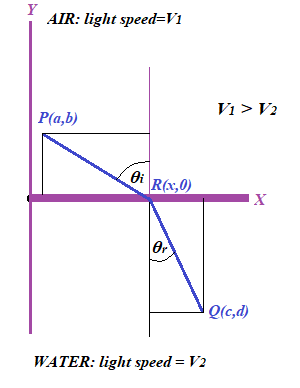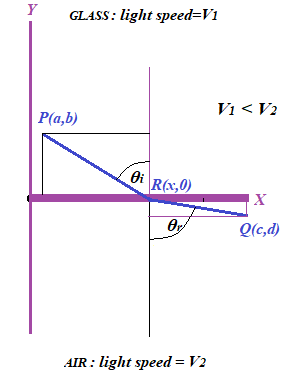Refraction
Refraction is an effect of changing the direction of light propagation after the light hits a border between two different media and penetrates into a new medium in, generally speaking, different direction and with different speed, as compared to the original direction and speed.
In this lecture we will quantitatively evaluate the effect of refraction from the viewpoint of the Fermat's Principle of the Least Time presented in the lecture about reflection of light.
Many experiments have shown that the direction of the ray of light after it crosses the border between two different media is determined by its initial direction before it hits the border and the properties of both media. In particular, it's the speed of light propagation before and after the border, as the main property of the medium, is taken into consideration.
The effect of refraction of light going from the air into the water is pictured below. The choice of air and water was not very important. Instead of them, any other two media could be mentioned, as long as the speed of light is greater in the top medium.

It can be shown that the plane that goes through points P, R and Q also contains the normal to a border surface at point R. That's the reason to present the refraction using only two dimensions of this plane.
The frame of reference has X-axis along the surface of water and Y-axis is normal to it.
The ray of light goes from the source P(a,b), which is in the air, into the water to point Q(c,d) by going along one straight line before it hits the water at point R(x,0) and then along the other straight line within the water to a destination point Q.
Our task is to determine the point R on the surface of the water, that is to determine the X-coordinate of this point, where the ray of light changes the direction.
The main criteria we will choose to determine the trajectory of light is the same Fermat's Principle of the Least Time we used to analyze the reflection of light in the corresponding lecture.
Let's determine the time needed for the ray of light to go along the trajectory from point P(a,b) in the air to point Q(c,d) in the water through point R(x,0) on the surface of water, where
b is positive,
d is negative and
a ≤ x ≤ c.
The first segment of this trajectory PR has the length, as a function of x
s1(x) = √(x−a)²+b²
The second segment RQ has the length
s2(x) = √(x−c)²+d²
Let's assume that the speed of light in the air is V1 and its speed in the water is V2.
Length and speed values determine the time needed for light to go through an entire trajectory.
The first segment requires the time
T1(x) = s1/V1 = √(x−a)²+b²/V1
The second segment requires the time
T2(x) = s2/V2 = √(x−c)²+d²/V2
According to Fermat's Principle of the Least Time, sum of these two times needs to be minimized to find the value of x - the position of the point R of refraction.
T(x) = T1(x) + T2(x) =
= √(x−a)²+b²/V1 +
+ √(x−c)²+d²/V2
The necessary condition for this function T(x) to have its minimum at x=x0 would be for its derivative by x to be equal to zero at this point.
Let's differentiate T(x) and see the implications of the condition T'(x0)=0.
T'(x) =
= 2(x−a)/(2√(x−a)²+b²·V1) +
+ 2(x−c)/(2√(x−c)²+d²·V2) =
= (x−a)/(√(x−a)²+b²·V1) +
+ (x−c)/(√(x−c)²+d²·V2) =
At this point it's convenient to express ordinates of points P and Q in terms of their abscissas and angles of incidence θi and refraction θr as follows
b = (x−a)/tan(θi)
d = (x−c)/tan(θr)
Using these expression, notice that
√(x−a)²+b² =
= √(x−a)²+(x−a)²/tan²(θi) =
= √(x−a)²·[1+1/tan²(θi)] =
= |x−a| /sin(θi)
√(x−c)²+d² =
= √(x−c)²+(x−c)²/tan²(θr) =
= √(x−c)²·[1+1/tan²(θr)] =
= |x−c| /sin(θr)
Substituting these expressions into T'(x), we obtain
T'(x) =
= (x−a)/[|x−a|·V1/sin(θi)] +
+ (x−c)/[|x−c|·V2/sin(θr)] =
= sin(θi)/V1 − sin(θr)/V2
Notice:
since a ≤ x ≤ c,
(x−a)/|x−a| = 1
(x−c)/|x−c| = −1
that's why the first item in the final expression for T'(x) is positive, the second one is negative.
Equality of T'(x) to zero implies:
sin(θi)/V1 − sin(θr)/V2 = 0
Therefore, the necessary condition for minimizing the time for light to travel from P to Q is not a straight line, but a set of two linked segments PR and RQ, inclined to the normal to a surface of refraction at angles that satisfy the equality
sin(θi)/V1 = sin(θr)/V2
Speed of light in any medium is a pretty large number, and it might be convenient to use a different form of the above formula. Let's introduce a concept of refraction index of any medium n=c/V, where c is the speed of light in the vacuum and V is the speed of light in the medium in question. Using n1=c/V1 and n2=c/V2 as the refraction indices of media involved in the refraction, the above condition on incidence and refraction angles looks like
sin(θi)·n1 = sin(θr)·n2
When the light falls perpendicularly to a surface that separates two media, an incidence angle is zero, θi=0. Under this condition the value of a refraction angle θr must also be equal to zero to satisfy the refraction equation above. It means that if the incident ray of light is perpendicular to a surface that separates two media, the refracted ray is also perpendicular to this surface, light does not change its direction, only the speed.
When the light goes from the medium of higher speed of light to the medium of a slower speed at any incidence angle greater than zero, the refraction angle will be smaller than incidence. As an incidence angle grows from 0 to π/2, a refraction angle grows from 0 to some maximum smaller than π/2.
A more interesting case can be observed, when the light goes from a medium with a slower speed into a medium, where its speed is higher. For example, from glass to air.
The following picture illustrates this case.

As an incidence angle grows from 0 to π/2, a refraction angle also grows from 0 up, but always greater than an incidence angle. That will result in some critical value of an incidence angle, when the refraction angle reaches π/2, that is will go parallel to a surface border between two media. Any further increase in incidence angle value will cause the light to stay within the area of a lower speed of light, it will be reflected by the surface border and will not go through it. This is called a total internal reflection.
This is the property of light used in fiber optics and jewelry.


No comments:
Post a Comment